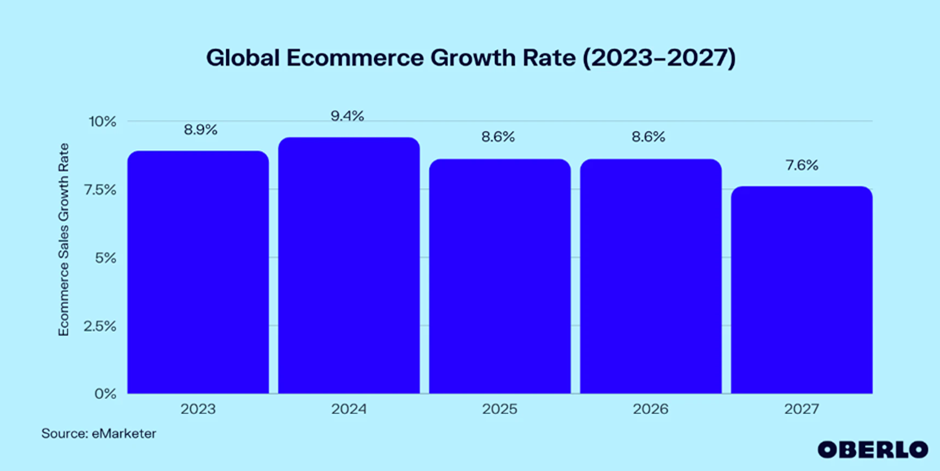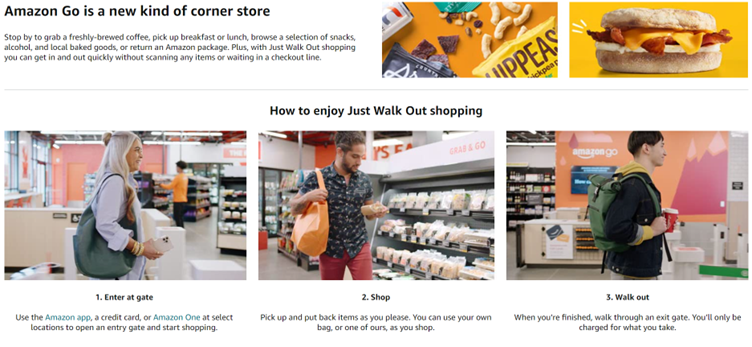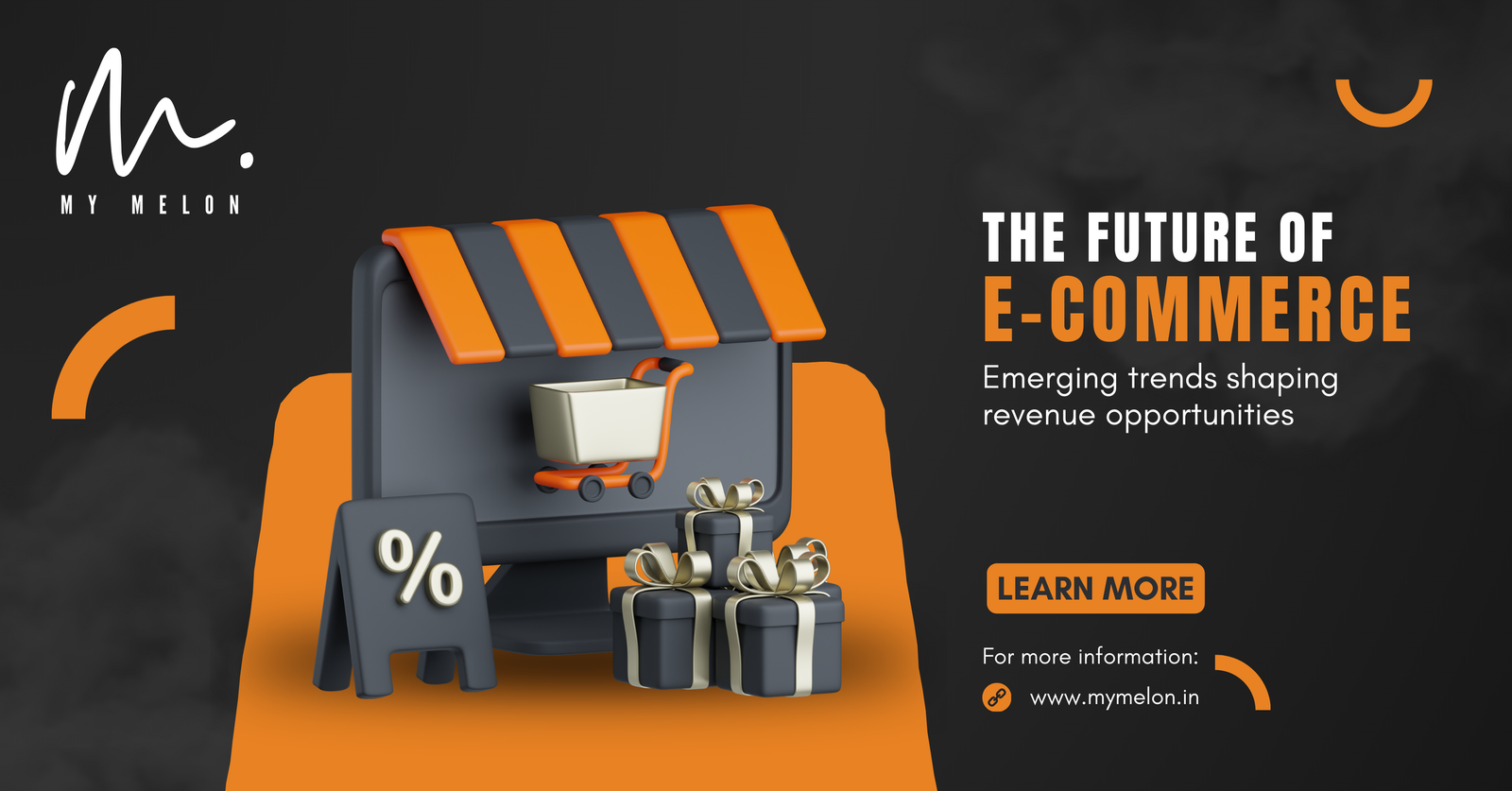The e-commerce landscape is constantly shifting, presenting new opportunities & challenges…These e-commerce trends are not just points of interest; they’re the keys to unlocking revenue opportunities & establishing a stronghold in the fiercely competitive world of online retail.
The E-commerce Landscape…
Before delving into the emerging trends, let’s first take a look at the current state of e-commerce… With online shopping becoming the new normal, Indian e-commerce is expected to grow at a compound annual growth rate (CAGR) of 27 percent to reach $163 billion by 2026, almost three times the growth of the overall retail market
E-commerce’s growth shows no signs of slowing down, making it a lucrative market for businesses to tap into.

From 2023 to 2027, the largest annual ecommerce sales growth is forecast to take place in 2024, and the smallest in 2027.
Key players like Amazon, Alibaba & Shopify dominate the e-commerce industry, but there is still ample room for smaller businesses to carve out their niche. However… challenges like increased competition, changing consumer behaviors, and evolving technology pose constant hurdles for e-commerce businesses.
Emerging Trends in E-commerce… A Roadmap to Success
Rise of AI & Machine Learning…
Artificial Intelligence (AI) & Machine Learning are revolutionizing the e-commerce sphere. These technologies are the driving force behind personalized shopping experiences and recommendation systems. Take Amazon, for instance; its sophisticated AI algorithms analyze customer browsing and purchase history to offer tailored product suggestions, greatly enhancing user engagement and sales.
Amazon’s Product Recommendations
Mobile Commerce (M-commerce)…
The world is witnessing a mobile revolution, and e-commerce businesses must ride this wave. Mobile commerce, or M-commerce necessitates prioritizing mobile-first design principles. Websites must be not only responsive but also optimized for seamless navigation and transactions on smartphones.
Additionally, integrating mobile payment options such as Apple Pay and Google Wallet streamlines the checkout process, mitigating the risk of cart abandonment and enhancing the user experience.
Augmented Reality (AR) and Virtual Reality (VR)…
Augmented Reality (AR) & Virtual Reality (VR) technologies are changing the game when it comes to immersive shopping experiences. With AR, customers can use their smartphones to visualize products within their own spaces before making a purchase. This ‘try-before-you-buy’ approach is exemplified by IKEA’s AR app, which enables users to envision how furniture items would fit in their homes.
Voice Commerce…
Voice commerce is experiencing remarkable growth, thanks to the proliferation of smart speakers like Amazon Echo and Google Home. Shoppers can simply voice their orders, making the purchasing process more convenient and frictionless.
Voice Shopping with Amazon Alexa
Sustainability & Ethical Shopping…
The modern consumer is increasingly conscientious about the environmental and ethical impact of their purchases. This has paved the way for e-commerce businesses to embrace sustainability and ethical sourcing.
Eco-friendly products, sustainable packaging, and transparent supply chain practices are now at the forefront of e-commerce strategies. Brands like Patagonia have taken the lead in adopting such practices, gaining the trust and loyalty of conscious consumers.
Patagonia’s Sustainability Initiatives
The Impact of Social Media: A Shaping Force…
Social media platforms are not just for connecting with friends and sharing photos; they are pivotal in shaping e-commerce trends. Two key aspects deserve our attention: influencer marketing and social commerce.
Influencer Marketing…
Influencers, individuals with substantial followings on platforms like Instagram and YouTube, wield tremendous influence over consumer behavior. Collaborating with influencers who align with your brand can significantly enhance product visibility and credibility.
Nike’s Collaboration with LeBron James
Social Commerce…
Social commerce represents a paradigm shift in e-commerce, enabling businesses to sell products directly on social media platforms. Instagram Shopping and Facebook Marketplace exemplify this trend, allowing users to browse, interact, and make purchases without leaving their preferred social networks.
Data Privacy & Security… Building Trust…
As e-commerce businesses collect an increasing amount of customer data, data privacy and security have become paramount concerns.
- A recent survey revealed that 81% of consumers are concerned about how companies handle their data.
- Regulations like the General Data Protection Regulation (GDPR) in Europe and the California Consumer Privacy Act (CCPA) have been implemented to safeguard consumer data.
- Businesses must build trust by implementing robust data protection measures and being transparent about their data practices.
E-commerce and Omnichannel Integration…
Consistent Branding…
Maintaining a consistent brand image and shopping experience across online and offline channels ensures customers recognize and trust the brand, whether they shop in-store or online.
Inventory Synchronization…
Integrating online and physical store inventory systems prevents overselling or underselling products and helps meet customer demand effectively.
E-commerce Advertising…
Here, let’s delve deeper into the main 3 key trends and strategies shaping the e-commerce advertising terrain.
Personalization…
E-commerce advertisers are increasingly harnessing the power of data-driven insights to craft highly personalized ad experiences. By analyzing customer behavior, preferences, and past interactions, businesses can tailor their advertisements to individual consumers. This personalization not only enhances engagement but also increases the likelihood of conversions as customers are more likely to respond to ads that align with their interests and needs.
Multi-Channel Marketing…
In the e-commerce landscape, it’s essential to reach customers wherever they are. Advertisers are embracing multi-channel marketing strategies which involve promoting products or services across various online platforms, including social media, search engines, email marketing & e-commerce marketplaces. This approach ensures a broader reach and allows businesses to engage with customers at different stages of their buying journey.
Programmatic Advertising…
Programmatic advertising, powered by artificial intelligence (AI) and machine learning, has revolutionized ad buying and placement in the e-commerce sphere. This technology allows advertisers to automate the process of selecting and delivering ads in real time, optimizing ad campaigns for better performance. Programmatic advertising also enables precise targeting, ensuring that ads reach the most relevant audiences which can lead to higher conversion rates and cost-efficiency.
Adaptive Strategies for Ad-blockers….
The rise of ad-blockers poses a significant challenge to e-commerce advertising. As more users employ ad-blockers to enhance their online experience, businesses must adapt to ensure their messages reach their intended audiences.
Ad-blockers and Countermeasures…
Ad-blockers are browser extensions or apps that prevent ads from displaying on web pages. To address this challenge, e-commerce advertisers can employ several strategies:
Native Advertising…
Native ads blend seamlessly with the content of a website, making them less likely to be blocked.
User Consent…
Some websites request user consent to display ads. Gaining this consent can lead to the unblocking of ads for specific users.
Improving Ad Relevance…
By delivering highly relevant and engaging ads, businesses can encourage users to disable ad blockers voluntarily.
Content Marketing…
Investing in content marketing can reduce reliance on traditional ads, allowing brands to deliver value and build relationships with customers.
Amazon Go… Revolutionizing In-Store Shopping with AI…
Amazon Go stands as a testament to the power of innovation in transforming traditional retail. Their cashierless stores have fundamentally redefined the in-store shopping experience. Leveraging advanced Artificial Intelligence (AI) and a network of sensors, Amazon Go has achieved what was once considered futuristic.
Customers entering an Amazon Go store are greeted by a seamless shopping journey. They can simply walk in, pick up the items they desire, and exit the store – all without the need for a traditional checkout process. The magic happens behind the scenes where AI algorithms track the items customers select and automatically charge their Amazon accounts as they exit.
This remarkable technological feat not only saves customers time but also eliminates the frustration often associated with long checkout lines. It’s an exemplary case of how AI and automation can enhance the convenience and efficiency of the shopping experience.

Warby Parker… Blending Online and Offline Experiences Seamlessly…
Warby Parker, a visionary eyewear retailer, has set a remarkable precedent for successfully merging the digital and physical realms of shopping. The brand’s ability to seamlessly integrate a robust online presence with brick-and-mortar stores is a testament to their innovative approach.
At the heart of their success is Warby Parker’s virtual try-on tool, a game-changer in the eyewear industry. This tool empowers customers to visualize how different glass styles will look on their faces, all from the comfort of their own homes. By utilizing augmented reality (AR) technology customers can get a realistic sense of how a particular pair of glasses will complement their facial features.

The virtual try-on tool not only simplifies the decision-making process but also addresses a longstanding challenge in the eyewear industry – the uncertainty of how frames will look on an individual’s face. It’s a prime example of how AR can enhance the online shopping experience bridging the gap between the digital & physical worlds.
To sum up…
The future of e-commerce holds immense promise and potential, shaped by emerging trends that offer substantial revenue opportunities. To thrive in this dynamic mania, businesses must be agile and adaptive, embracing changes in technology, consumer behavior & industry regulations.
MyMelon, as your trusted digital marketing agency, is committed to guiding your journey ensuring that you remain at the forefront of e-commerce trends and seize the revenue opportunities it brings…



